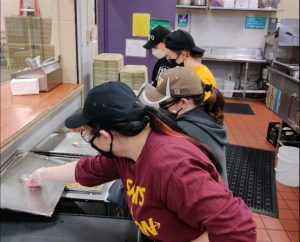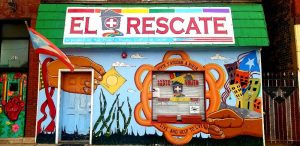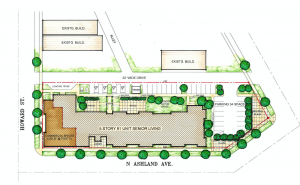Three may be the charm for developer Chris Fifield, who is sending his third proposal for a Chicago Avenue building to the East Village Association and Ald. Proco Joe Moreno (1st) for review and approval this month.
The plan will be sent to the East Village Association by the end of the month, said association president Neal McKnight.
The proposed building, between Wolcott Avenue and Wood Street, would add 39 one-bedroom apartments to a part of West Town that lacks studio spaces, Fifield said. The first floor would be retail space.
The lot’s zoning restrictions would allow only 39 one-bedroom units for how Fifield has designed the building. But earlier this fall, his company changed the initial proposal to include 63 units and more stories—a change that required a zoning modification
The association’s approval or rejection has no legal implications, but members’ opinions are generally considered by Ald. Moreno, who can help Fifield secure necessary permits. Fifield said he wants to make residents feel comfortable with the project.
“Our goal is to build more buildings in the area,” said Fifield, founder of Fifield Construction. “And a good way is to maintain a good relationship with the East Village Association.”
If the plans are approved, construction could begin as early as May or June, he said.
Members of the East Village Association and Chicago Grand Neighbors Association opposed the plan change, saying they were concerned about excessive traffic and residential density, McKnight said.
“We wrote letters on behalf of Chicago Grand Neighbors Association and East Village Association to Ald. Moreno saying that we oppose the zoning change,” said Lyn Wolfson, president of Chicago Grand Neighbors. “We thought the current zoning allowed really enough apartments and that (Fifield Construction) would be able to do good things.”
In its third revision, the plan Fifield is sending to the East Village Association and the alderman will include 39 residential units, three of which would be live-work spaces. Each of these three units would be divided in to an art studio space and living quarters, a concept Fifield said “goes with the general vibe of the area.”
The live-work units require a special use permit, Fifield said, granted by the city.
No matter what building plan is adopted, Fifield said there will be some increase in traffic congestion on Chicago Avenue because an empty lot would turn in to a functioning building.
“Our current proposal results in less traffic,” Fifield said. “By building 39 units instead of 63, we’re building what the city has planned for the area to withstand in respect to traffic flow.”
In a block dotted with many small, Latino-based grocery stores and restaurants, one business owner said the proposed building should be a contrasting large store that would attract more people—not an apartment building with small retail space.
“We need something to draw people in,” said Karen Walaszek, owner of Master Medical Supplies, which is adjacent from the empty lot. “This is a dead block.”
Walaszek argued there are enough small businesses and living spaces in the area. She added that the building’s new residents would likely leave the block to shop at a popular, “brand-name” store like Trader Joe’s or Dominick’s.
But Santigo Salgado, co-owner of Salgados Fashions, which is also across from the empty lot, said new residents will simply give more business to stores like his.
The empty lot is fenced off from Commercial Park a block north of Chicago Avenue and has an entryway on a small road called Rice Street.
Traffic congestion and safety for playing children has been voiced as a concern, but one park district worker said she doesn’t think the park will be affected.
“The traffic will be on Chicago—there’s never really traffic on Rice,” said Rochelle Deleon, a children’s recreation group leader at the park.
If the plan is approved and the special use permit for the live-work spaces is acquired, construction will last for a year once ground is broken in the summer.













Be First to Comment